Flaky and Golden: The Best Crispy Fish Batter Recipe
Crafting the perfect crispy fish batter requires more than just mixing ingredients.
Salt and flour dance together, creating a magical coating that turns ordinary seafood into a crisp delight.
Unexpected techniques can elevate your kitchen game to professional levels.
Professional chefs guard their secrets, but we’re breaking down barriers to help you master this technique.
Each ingredient plays a crucial role in achieving that golden, crunchy exterior you crave.
Texture matters as much as flavor, so pay attention to how you blend and apply the batter.
Crunch into this delectable recipe and watch your dinner guests marvel at your culinary skills.
Crispy Fish Batter Delivering Crunchy Perfection Every Time
Ingredients To Make Crispy Fish Batter
Main Ingredients:Dry Seasoning Ingredients:Cooking Ingredients:Optional Serving Accompaniments:How To Prepare Crispy Fish Batter
Step 1: Prepare Your Fish
Get your fish fillets and gently pat them completely dry using paper towels. This crucial step helps create that irresistible crispy exterior.
Sprinkle a light layer of salt and pepper across both sides of the fish for delicious seasoning.
Step 2: Create Magic Batter
Grab a mixing bowl and combine your dry ingredients:Slowly pour in cold sparkling water or beer while whisking.
Blend until the mixture becomes smooth with a silky consistency. Don’t overmix – you want a light, airy texture.
Step 3: Heat Cooking Oil
Select a deep skillet or fryer and pour vegetable oil. Warm the oil until it reaches 350 degrees Fahrenheit.
The oil should be deep enough to fully submerge your fish pieces.
Step 4: Coat Fish Perfectly
Dust each fish fillet with a thin flour layer, shaking off any excess.
Dunk the floured fish into your prepared batter, ensuring complete coverage. Let extra batter drip off before frying.
Step 5: Fry to Golden Perfection
Gently lower battered fish into hot oil. Cook in small batches to maintain oil temperature.
Fry each piece for 3-5 minutes per side until the exterior turns gorgeous golden brown. The fish should flake easily when done.
Use a slotted spoon to transfer fried fish onto paper towels for draining.
Step 6: Serve and Enjoy
Plate your crispy fish immediately while piping hot.
Serve alongside tangy tartar sauce, fresh lemon wedges, and classic coleslaw or crispy french fries for an amazing meal.
Tips To Achieve Perfect Crispy Fish Batter
Flavor Variations To Try With Crispy Fish Batter
Serving Suggestions For Crispy Fish Batter
Storage Guidelines To Keep Crispy Fish Batter Fresh
FAQs
Removing excess moisture helps the batter stick better and creates a crispier coating by preventing steam buildup during frying.
Yes, white fish like cod, haddock, halibut, or tilapia work best because they have a mild flavor and firm texture that holds up well during frying.
You can substitute with cold water, but sparkling water or beer adds extra lightness and helps create a crispier, airier batter due to the carbonation.
Print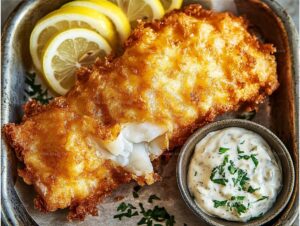
Crispy Fish Batter Recipe
- Total Time: 25 minutes
- Yield: 4 1x
Description
Crispy fish batter elevates seafood with golden, light-as-air perfection. Crunchy exterior and delicate inner layers promise a delightful coastal-inspired feast you’ll crave again and again.
Ingredients
Main Ingredients:
- 1 cup all-purpose flour
- 1 cup cold sparkling water (or cold beer)
- 4–6 fish fillets (cod, haddock, or tilapia)
Dry Seasonings:
- 1/4 cup cornstarch
- 1 teaspoon baking powder
- 1/2 teaspoon salt
- 1/4 teaspoon black pepper
- 1 teaspoon garlic powder
Cooking Ingredient:
- Vegetable oil, for frying
Instructions
- Thoroughly dry fish fillets using paper towels, eliminating excess moisture. Season with salt and pepper, then set aside at room temperature.
- Create a delicate batter by combining flour, cornstarch, baking powder, seasonings in a mixing bowl. Gradually incorporate cold sparkling water or beer, whisking until smooth with a light, airy consistency. Avoid overmixing to preserve batter’s delicate texture.
- Prepare frying station by heating vegetable oil in a large skillet or deep fryer to precisely 350F (175C). Ensure oil depth is sufficient for complete fish submersion.
- Prepare fish for frying by lightly coating each fillet in flour, gently shaking off surplus. Dunk floured fish into prepared batter, ensuring complete coverage. Allow excess batter to drip off before cooking.
- Gently lower battered fish into sizzling oil, maintaining small batch sizes to prevent temperature drop. Fry each piece for 3-5 minutes per side until exterior achieves a golden, crisp texture. Fish is ready when it flakes effortlessly with a fork. Extract with a slotted spoon and drain on paper towel-lined plate to remove excess oil.
- Serve piping hot, accompanied by tangy tartar sauce, fresh lemon wedges, and classic sides like coleslaw or crispy french fries for a satisfying meal.
Notes
- Ensure fish fillets are thoroughly dry to achieve maximum crispiness and prevent oil splattering during frying.
- Use cold sparkling water or beer for an extra light, airy batter that creates a delicate, crisp coating.
- Keep oil temperature consistent at 350F to guarantee even cooking and prevent greasy texture.
- For gluten-free option, swap wheat flour with rice flour or gluten-free all-purpose flour blend.
- Prep Time: 15 minutes
- Cook Time: 10 minutes
- Category: Lunch, Dinner, Appetizer, Snacks
- Method: Frying
- Cuisine: British
Nutrition
- Serving Size: 4
- Calories: 280 kcal
- Sugar: 0 g
- Sodium: 370 mg
- Fat: 3 g
- Saturated Fat: 0.4 g
- Unsaturated Fat: 2.6 g
- Trans Fat: 0 g
- Carbohydrates: 56 g
- Fiber: 1.5 g
- Protein: 8 g
- Cholesterol: 45 mg

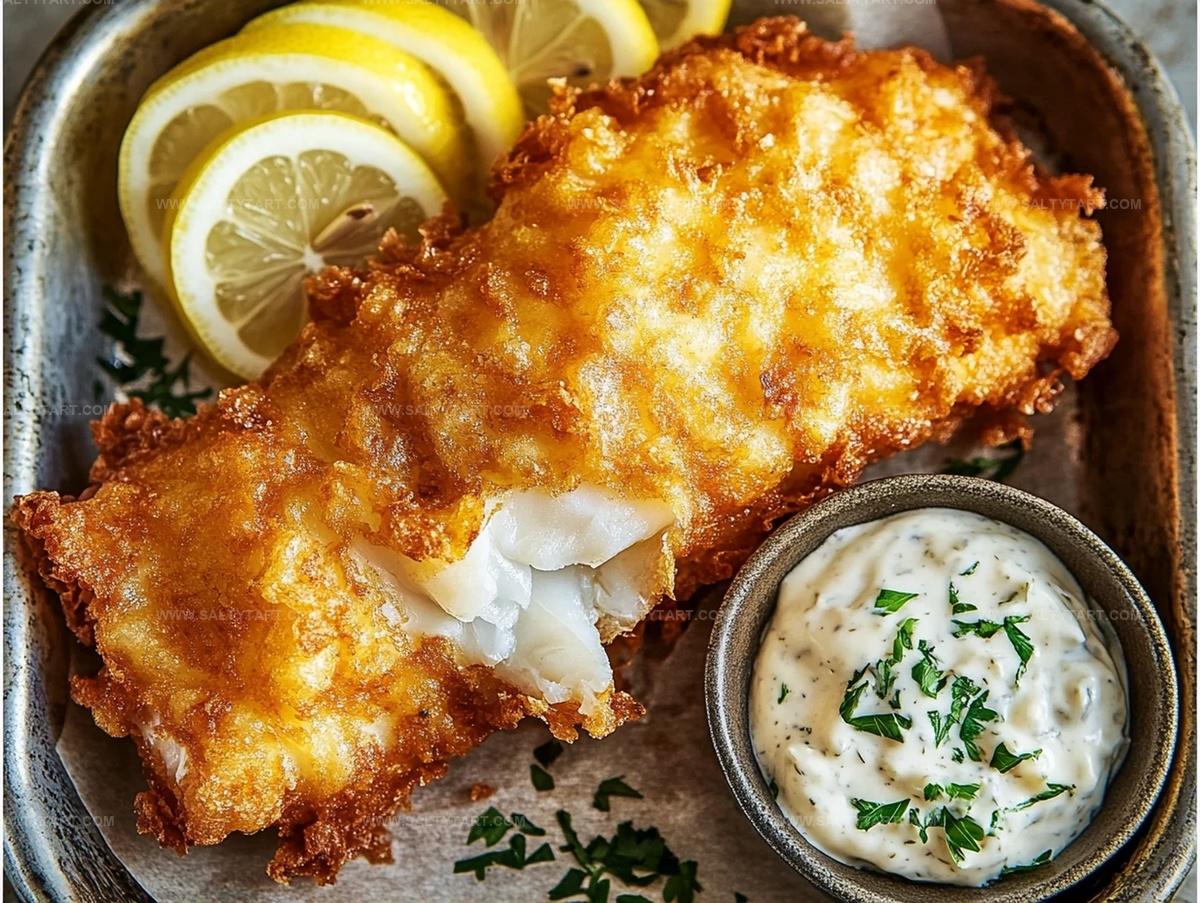
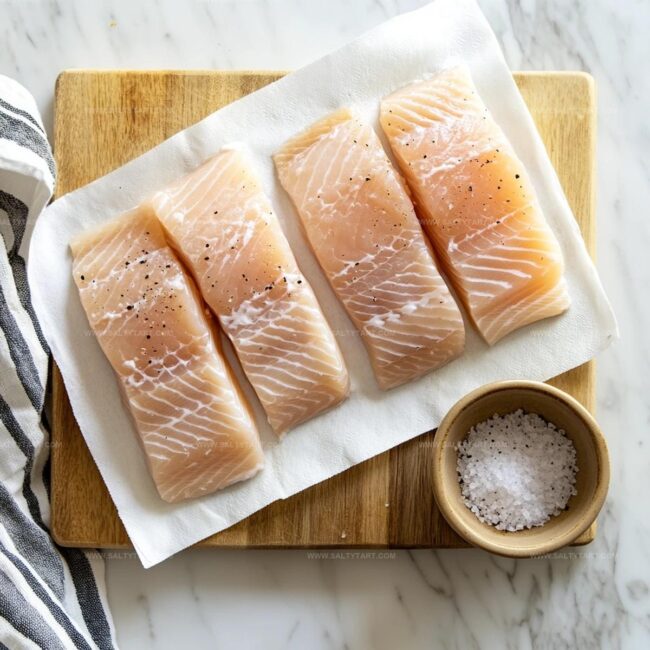
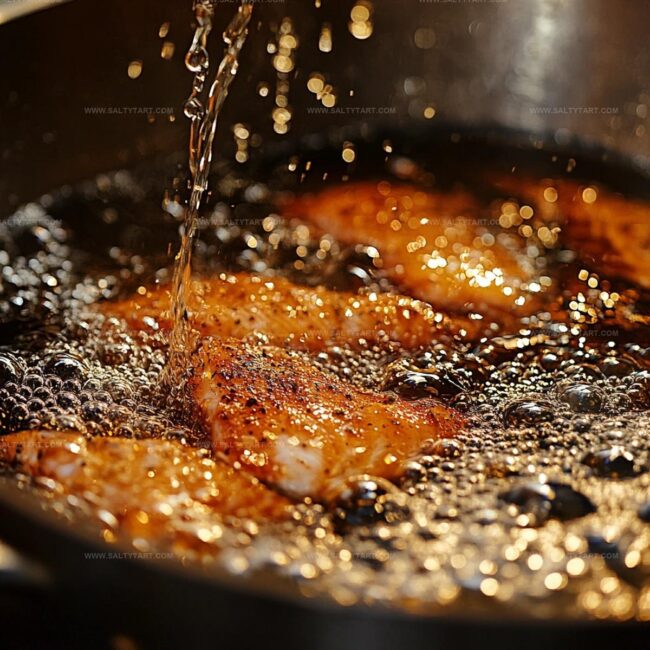
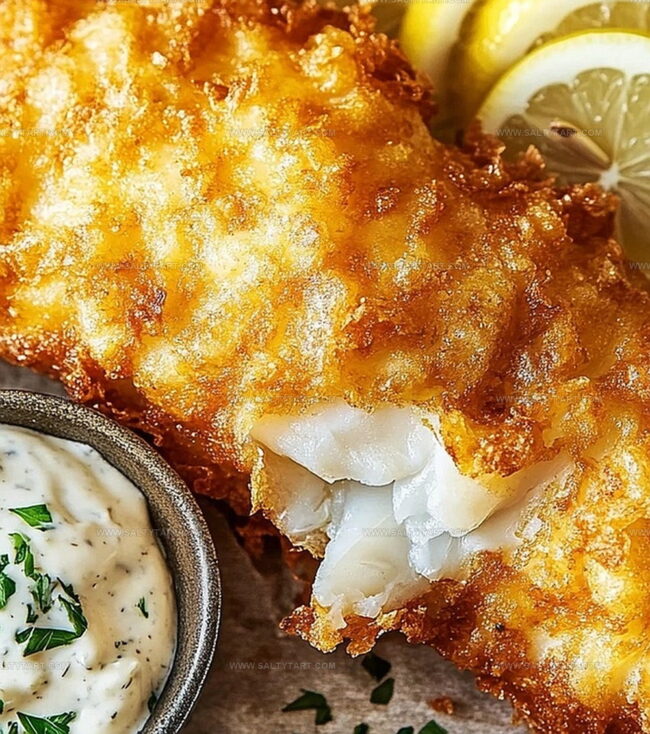
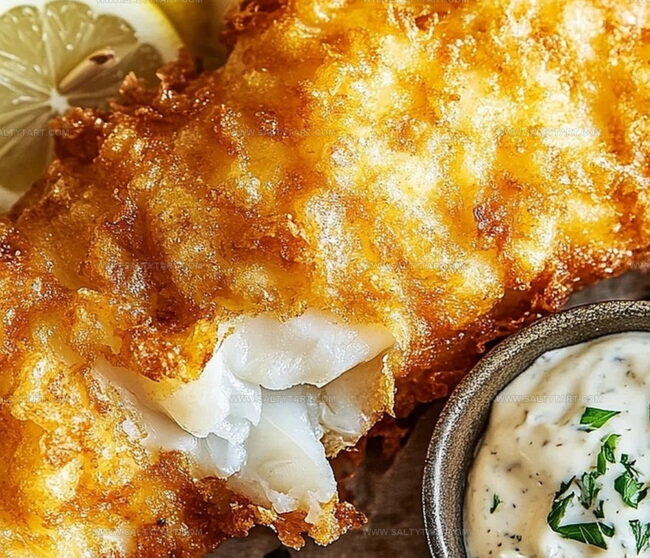
Mike Reynolds
Founder & Recipe Developer
Expertise
Farm-to-table cuisine, Seasonal recipe development, Sustainable cooking techniques, Food photography
Education
Asheville-Buncombe Technical Community College (A-B Tech)
Associate Degree in Culinary Arts
Mike studied culinary arts with a strong focus on farm-to-table principles and sustainable cooking. His training emphasized the importance of fresh, local ingredients and environmentally responsible practices in the kitchen.
Mike’s food journey began deep in the Blue Ridge Mountains, where weekends at farmers’ markets and home-cooked meals sparked a lifelong obsession with simple, seasonal eating.
After earning his Associate Degree in Culinary Arts from Asheville-Buncombe Technical Community College, he set out to bring farm-to-table cooking into everyday kitchens, without the fuss.
Mike’s philosophy is all about keeping it fresh, unfussy, and full of heart. When he’s not crafting new single-serving recipes, he’s hiking mountain trails, chatting with local farmers, or experimenting with wild ingredients in his backyard kitchen.